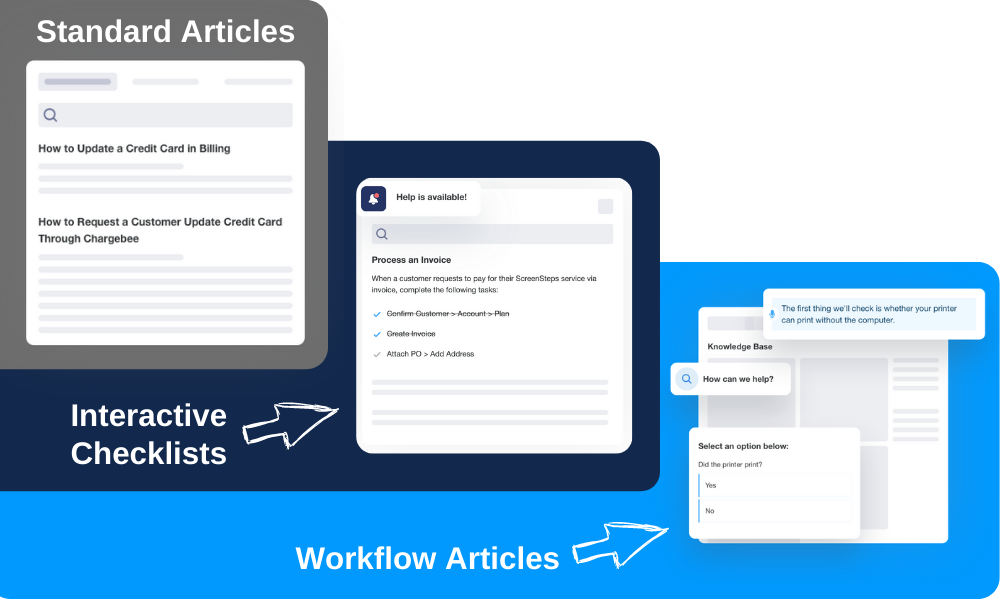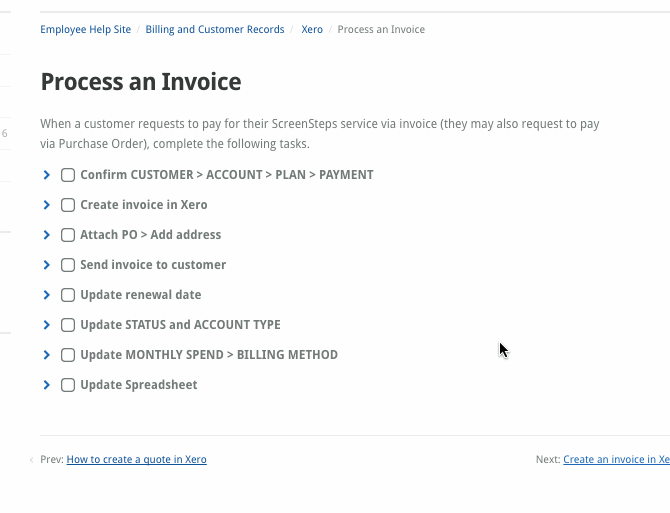12 signs that show your client needs ScreenSteps
As a consultant, you have all the right answers. At least, that’s what your clients believe when they come to you to solve their problems.
You’re the MVP quarterback of this team. You’re the Gandalf the Grey of this story. You’re even the Fairy Godmother who seemingly waves her wand and everything is fixed (though we know it takes a lot of work on your part).
The point is you’re there to lead your clients to the right solution — which means you are always searching for new and innovative resources to solve your clients’ problems.
And you want to bring them the top solutions that will add value for your clients.
ScreenSteps is a specialized knowledge base software and training solution to add to your portfolio of business solutions.
With ScreenSteps, managers and trainers can quickly create procedure documents and make them available to employees in their moment of need. Companies use it to train employees during technology rollouts and performance support for everyday operations.
There are many different scenarios in which ScreenSteps can help a company and each one is unique.
Note: If you are a small team of five or fewer people, you won’t necessarily need something like ScreenSteps. It’s when volume — whether that be the number of employees or number of transactions — increases that ScreenSteps best comes into play.
Below, I’ll provide you with 12 specific scenarios so that you know when you can offer ScreenSteps as a solution to your clients.
-
- One person knows all the answers (but no one else does)
- No one reads the technical guides
- Employees are regularly making mistakes
- Employees can’t find procedure guides in their system
- Clients are rolling out a new system and don’t have system documentation
- New hires spend a lot of time shadowing
- Delegating is impossible
- Technical guides aren’t written in-house
- IT Help Desk is pounded with questions
- They need post-implementation support
- They have little or no system for documenting procedures
- It takes a long time to write or update a user guide
Sign #1: One person knows all the answers (but no one else does)
When only one person has all the answers, then they will spend every day being the company’s encyclopedia.
Often, the expert is a supervisor or manager. These leaders typically are supposed to work on high-level organization and management assignments. Instead, they lose all their time answering employee questions and can’t get any of their own work done.
Plus, what would happen to the company if this person randomly decided to quit one day?
How ScreenSteps helps
ScreenSteps takes the pressure off of the one Mr. Know-It-All and provides everyone an opportunity to be an expert.
By filling your knowledge base, you take the information out of your expert’s brain and put it in a location where every member of your team can access it.
ScreenSteps makes it easy for your experts to document the information in their heads. Our robust content creation tools include screen captures and annotations so that experts can both tell and show how to do tasks.
That means if they have a question, all they have to do is type their question in the search bar. Using keywords, the search will pull up an answer or a process to follow.
This frees up time for your managers and supervisors so they can complete their own workload.
Sign #2: No one reads the technical guides
Maybe your client’s company already has documentation in the form of technical guides. However, nobody is reading them.
How do you get employees to read the technical guides so they can follow the proper procedures?
How ScreenSteps helps
The harsh reality is that nobody reads technical guides because they are way … well ... too technical. The language used to write technical guides is boring, distracting, and difficult to understand.
Put simply — people don’t talk or think like technical guides are written.
ScreenSteps helps managers and supervisors re-write technical guides and break them down into everyday terms that your employees can easily understand and follow.
We can help by giving your client’s technical writers better tools for writing clearer instructions. Those come in the form of workflows, checklists, prompts, screenshots, and more.
Sign #3: Employees are regularly making mistakes
Your clients are noticing that their employees can’t remember how to perform tasks or where to find the procedure documents. Even when your clients have some form of documentation, their employees are still making mistakes.
They are consistently using their systems incorrectly and struggling to perform procedural tasks without errors.
How ScreenSteps helps
Don’t expect new hires to memorize all of the companies procedures and policies — or even which folder to find the answers in — during onboarding.
Stop memorizing. Instead, teach them to follow the guides in ScreenSteps.
ScreenSteps promotes a training approach called Zero Memorization. In Zero Memorization, employees don’t memorize company processes. Instead, they learn how to find the answers in your ScreenSteps knowledge base.
Using the Zero Memorization training strategy, companies have decreased the amount of time in training by up to 90% without compromising accuracy. In fact, accuracy tends to increase.
Sign #4: Employees can't find procedure guides in their system
Your client has documented their procedures in PDFs, PowerPoints, or Word Documents — but their employees still can’t find the guides.
Even though they’ve organized these documents into folders on SharePoint or some other cloud service, they are still struggling to locate the right document when they need it.
Why can’t they find the documents? There are too many of them.
Before using ScreenSteps, some of our customers had to have at least 10 different PDF guides open (which were 15-300 pages apiece) as well as multiple web windows open in order to complete a task.
It made it impossible for their employees to find what they needed. Since they couldn’t find them, they weren’t using the guides.
How ScreenSteps helps
With a ScreenSteps knowledge base, you can put all of your guides and resources into one location. And unlike many knowledge bases, it is easy to find content in ScreenSteps.
The ScreenSteps knowledge base is easy to search. Think of it as a Google Search engine specifically for your client’s procedures.
Using common phrases, employees can easily find anything in a few clicks. No more digging through folders to try and find intricate information.
And they won’t have to bounce around between 10 different documents and multiple web windows to find the resources you need.
Sign #5: Clients are rolling out a new system and don't have system documentation
When your client is rolling out a new system, failure is not an option.
If they are spending thousands of dollars on the implementation, it must work and your client’s employees must use it to see the ROI.
Ideally, your client will already have documentation that their employees can reference while learning the new system. If they do not, they are going to be in trouble.
How ScreenSteps helps
Very few consultants enjoy creating system documentation. But with ScreenSteps, consultants have actually used the term “fun” to describe writing user guides.
Prepare and document procedures on how to implement the new system that your client’s employees can use in your ScreenSteps knowledge base.
Then train employees using the Zero Memorization methodology. This means you will train them on how to search the ScreenSteps knowledge base to perform tasks in the new system.
Sign #6: New hires spend a lot of time shadowing
Following training, do your new hires need to shadow experienced employees for a long period of time?
How long does it take before your new hires are confident enough to work independently?
The longer new hires spend shadowing the longer your company is paying two different people to do one job.
How ScreenSteps helps
Cut down the amount of time new hires spend shadowing by creating a knowledge base that they can reference during any process or procedure. Then, use the Zero Memorization training methodology to teach your reps how to use it.
When you use the Zero Memorization training methodology, you are teaching your client’s employees to constantly turn to your knowledge base for answers.
During training, you can have regular exercises where you put employees through scenarios. For example, “How do you process an invoice payment?”
The new hire class will search the knowledge base for the answer.
By doing scenario-based training, they will build confidence as they find the answers on their own.
Sign #7: Delegating is impossible
Since one person is designated as the expert at handling questions, it makes it nearly impossible to delegate assignments.
There is no other resource outside of another human being for where an employee can get information.
This puts an especially heavy burden on one person.
How ScreenSteps helps
Document all of the information your client’s experts are keeping in their heads. Have your experts write articles for the processes they are the only ones that complete a task.
Using both words and images, the experts can articulate and illustrate how to complete a process.
Writing an article can take as little as minutes with easy-to-use documentation tools including integrated screen capture, arrows, foldable sections, and more.
With the information documented in the knowledge base, everyone has access to the answers and can complete the tasks. Delegation becomes the status quo.
Sign #8: Technical guides aren't written in-house
Your company doesn’t write the technical guides. They are written elsewhere.
Oftentimes, we see these technical guides are written overseas or in another country, but they are going to be used by a team in Connecticut.
The problem is that the jargon is complicated and your workers don’t understand the directions they’ve been given.
How ScreenSteps helps
ScreenSteps makes it easy for the team that is using technical guides to create those guides. And we make it simple to build and organize those articles so they are easy to read.
So if your team in Connecticut needs a guide for setting up appointments at 54 different local doctors’ offices, then experts on your team will write those guides.
We can help by making it easy to import the technical guides into ScreenSteps and giving managers/trainers the ability to modify the guides so that they are easier to read.
We have three different types of articles to help best communicate processes: standard articles, interactive checklists, and workflow articles.

Standard articles allow you to document your policies in the form of simple how-to guides, FAQs, and policies.
Interactive checklists are used to make sure employees don’t miss a step of the process. They are also built to be flexible on the amount of information they provide, so they can adapt to new and experienced employees.
Workflow articles function as interactive decision trees. They are built so employees can answer questions and it quickly guides them based on their answers.
Sign #9: IT Help Desk is pounded with questions
Any time that employees run into a minor problem with the software or program, they reach out to the IT Help Desk to resolve the issue.
The problem is that the IT Help Desk will be overwhelmed with questions if they can’t quickly respond and/or get a one-contact resolution.
If Help Desk agents have to explain the same things in an email after email, they will be overwhelmed. They shouldn’t have to recreate the wheel each time a problem pops up.
How ScreenSteps helps
The way ScreenSteps helps is by helping companies codify procedures so that employees can reference them when responding to an inquiry.
Plus, with screenshots, it’s much easier to explain to users what to do and how to do it because it’s so visual.
Interactive checklist articles are helpful in making sure IT Help Desk employees cover all of their bases when they are resolving issues. They can run through a list, expand sections if they don’t understand a checkpoint, and mark them off as they are completed.

Sign #10: They need post-implementation support
For a big implementation, a lot of attention is focused on the rollout training.
But after they launch the system, there are still going to be changes that need to be communicated to employees.
Most implementations will see a high volume of change requests during the first six months after implementation. If your client isn't capturing those changes and creating user guides, employees are going to feel lost.
Plus, what are you going to use to train employees?
How ScreenSteps helps
When you use the ScreenSteps knowledge base, we offer coaching and implementation services for an additional cost.
We understand the pressure of needing to launch a system when failure is not an option. This is why we set up individual plans that involve pre-launch, launch, and post-launch support.
As part of the coaching, we can create customized training for your content authors, help you design a content strategy, set up a Zero Memorization training event, and more assistance tailored to your company.
Our goal is for your team to be successful in integrating a new system into your company.
Sign #11: They have little or no system for documenting procedures
You have excellent employees and they are great about documenting procedures.
In this case, the problem is that all of the documentation is inconsistent. When someone pulls up an article they are not the author of, it makes it more difficult to follow the guide and find the answers they need.
There is no organization for how or even who will write down these policies and procedures so that everyone can use the same documents.
And because of this, there may be a lot of duplicate documents covering the same materials.
How ScreenSteps helps
ScreenSteps breaks through the inconsistencies and helps you set up a system the whole company can use for documentation.
You can develop a style guide for your client’s content creation team. It’s easy to stay consistent with ScreenSteps since you can create templates and presets.
Plus, since ScreenSteps is set up for teams to create articles, there are collaboration features in authoring management. A supervisor or manager can provide feedback and edits on articles before they are pushed live.
This will change the way both your content creation authors and the end-users approach your knowledge base. They will actually want to use the guides and feel confident that they can find the answers they are searching for.
Sign #12: It takes a long time to write or update a user guide
Any time there is a change in a procedure it takes weeks or months before the resources are updated with the correct information.
If your company uses PDFs, Word Documents, or printed documents, then employees are often working out of the old documents instead of having the up-to-date procedures.
Your employees always seem to be working a few steps behind in the fast-changing business procedures.
How ScreenSteps helps
Your knowledge base is a living and breathing resource center. As your procedures change or as new products are added to your company, they need to be added to your knowledge base immediately.
With most companies, that task can be daunting since it could take days or weeks to update. With ScreenSteps’ quick content creation tools, it can take minutes or hours depending on the extent of the update.
These changes are immediately updated in your knowledge base so that your team can start following the new procedures right away.
One of our clients was able to create 4Xs the number of documents in ¼ of the time using ScreenSteps.
Think ScreenSteps is a good fit for your client?
If your clients have run into any of the above issues, ScreenSteps can help make them manageable.
There are a variety of ways ScreenSteps can help handle business operations at your company. To oversimplify it, most companies use ScreenSteps for these three purposes:
- To speed up documentation
- To set up a one-stop-shop for employee questions
- To train employees so they can easily find the right answers
With our robust content creation tools, they speed up the documentation process.
They build out their knowledge base — which is easy to search and access answers — so that employees have the guides they need at their fingertips.
Then they speed up their training process while relieving employee stress, helping employees work confidently, and increase accuracy in completing tasks.
Are any of these results something your client needs?
We’ve worked with multiple consultants to help provide business solutions to companies. We’d love to work with you to create strategies that will help your clients reach their goals and see greater results.
Contact one of our representatives to learn more about ScreenSteps and how we can work together.


.png)
